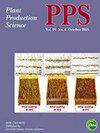具有AA以外的各种基因组的野生水稻物种对洪水的适应性反应
IF 1.3
3区 农林科学
Q2 AGRONOMY
引用次数: 2
摘要
摘要本研究对15份不同于水稻基因组组的野生水稻材料在幼苗和成熟期对洪水的适应性反应进行了测试。在幼苗期完全淹没的情况下,微小O.minuta和四倍体O.punctata、O.eichingeri、O.officinalis、O.alta、O.grandgrumis、O.latifolia和O.australiensis的材料在恢复期后的水下芽伸长降低,存活率高。这表明这些物种在幼苗期表现出耐淹性。在成熟期的逐渐淹没过程中,二倍体和四倍体的O.punctata、O.alta、O.grandoglumis、O.latifolia和O.brachyantha的材料节间伸长得到了促进。这表明这些物种具有漂浮能力。值得注意的是,两个CCDD基因组物种,即大颖和宽叶,在幼苗期表现出强烈的耐淹性,在成熟期表现出较强的漂浮能力,这表明这些物种是提高水稻对洪水适应性的宝贵遗传资源。已知SUB1A和SNORKEL基因分别赋予O.sativa耐淹性和漂浮能力。然而,在本研究中调查的任何野生水稻材料中都没有检测到SUB1A、SNORKEL1和SNORKEL2基因。我们的研究结果表明,在所研究的野生水稻物种中,对洪水的适应性反应可以独立于SUB1A和SNORKEL基因的存在或不存在而实现。图形摘要本文章由计算机程序翻译,如有差异,请以英文原文为准。
Adaptive responses to flooding in wild rice species with various genomes other than AA
ABSTRACT In the present study, 15 accessions of wild rice species belonging to genome groups different from that of Oryza sativa were tested for their adaptive response to flooding at the seedling and mature stages. Under complete submergence at the seedling stage, reduced underwater shoot elongation and high survival rate after the recovery period were observed in the accessions of O. minuta as well as tetraploid O. punctata, O. eichingeri, O. officinalis, O. alta, O. grandiglumis, O. latifolia, and O. australiensis. This suggests that these species exhibit submergence tolerance at the seedling stage. During gradual submergence at mature stage, promoted internodal elongation was observed in the accessions of diploid and tetraploid O. punctata, O. alta, O. grandiglumis, O. latifolia, and O. brachyantha. This suggests that these species possess floating ability. Remarkably, two CCDD genome species, namely O. grandiglumis and O. latifolia, strongly displayed both submergence tolerance at the seedling stage and floating ability at mature stage, suggesting that these species are valuable genetic resources for improving rice adaptability to flooding. SUB1A and SNORKEL genes are known to confer submergence tolerance and floating ability to O. sativa, respectively. However, SUB1A, SNORKEL1, and SNORKEL2 genes were not detected in any of the wild rice accessions investigated in the present study. Our results suggest that adaptive responses to flooding in the investigated wild rice species can be achieved independently of the presence or absence of SUB1A and SNORKEL genes. GRAPHICAL ABSTRACT
求助全文
通过发布文献求助,成功后即可免费获取论文全文。
去求助
来源期刊

Plant Production Science
农林科学-农艺学
CiteScore
5.10
自引率
4.00%
发文量
27
审稿时长
>36 weeks
期刊介绍:
Plant Production Science publishes original research reports on field crops and resource plants, their production and related subjects, covering a wide range of sciences; physiology, biotechnology, morphology, ecology, cropping system, production technology and post harvest management. Studies on plant production with special attention to resource management and the environment are also welcome. Field surveys on cropping or farming system are also accepted. Articles with a background in other research areas such as soil science, meteorology, biometry, product process and plant protection will be accepted as long as they are significantly related to plant production.
 求助内容:
求助内容: 应助结果提醒方式:
应助结果提醒方式:


